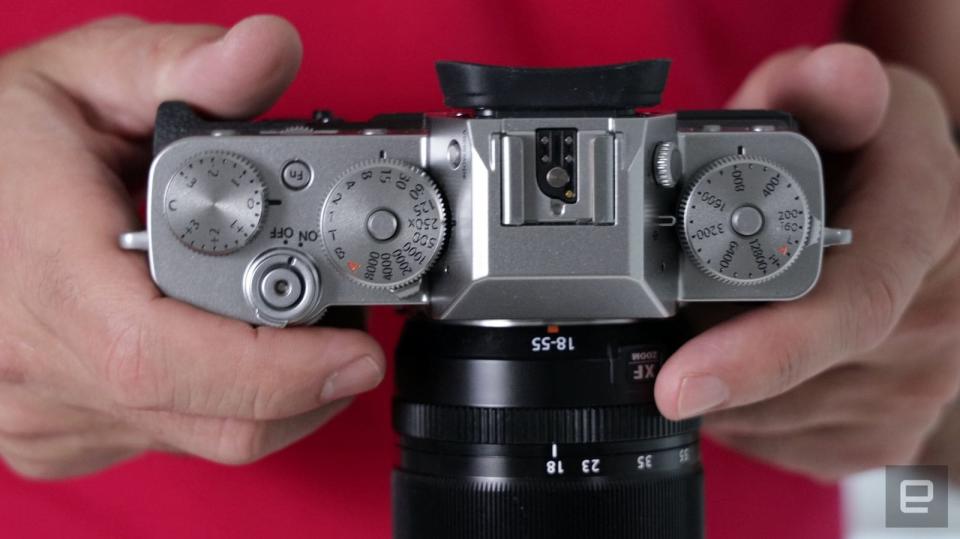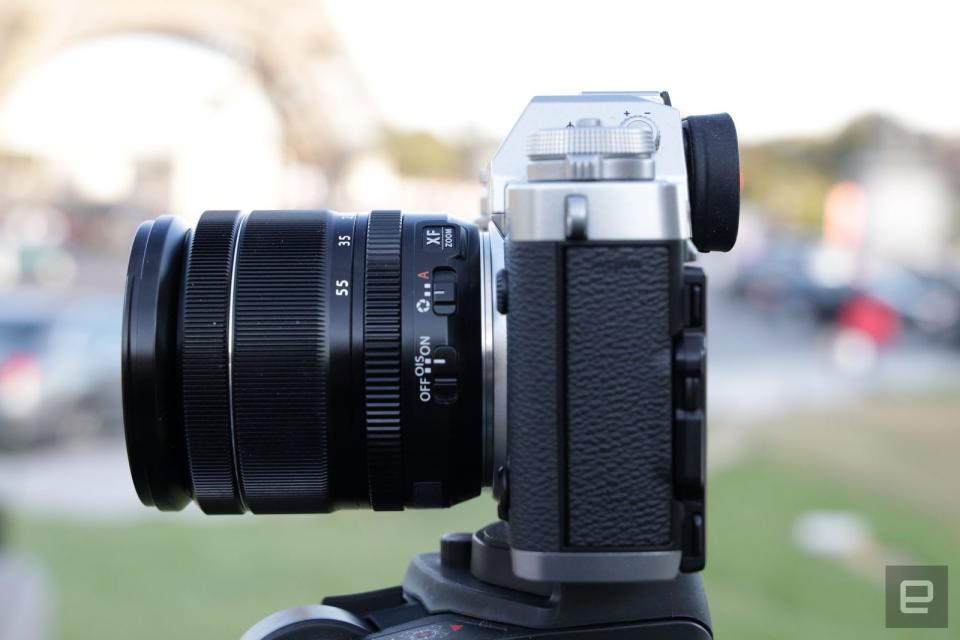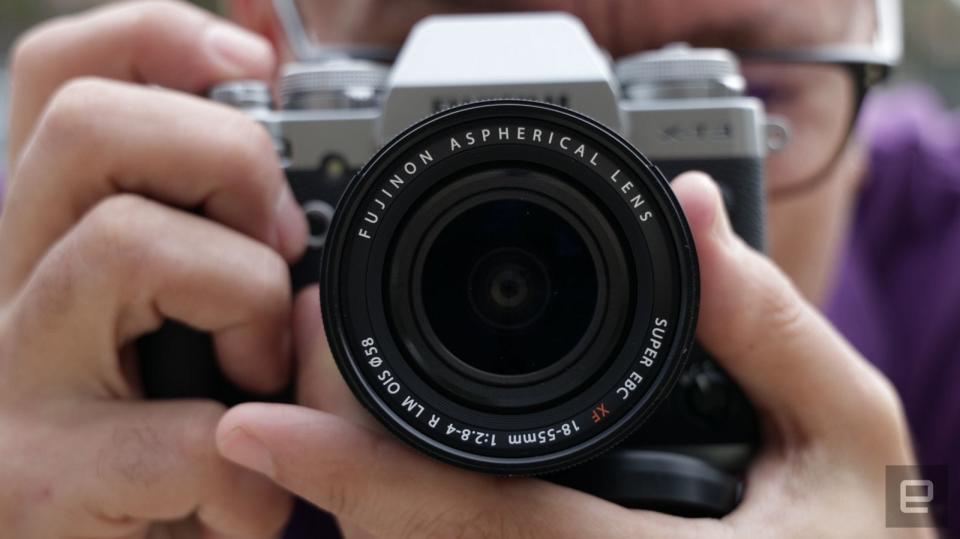Fujifilm X-T3 review: An X-Series camera that gets video right
Much better autofocus and speed, too.
Fujifilm's X-T3 sure looks a lot like the X-T2, but don't be deceived. Aside from the handsome, compact body, this is a smarter, more capable mirrorless camera in almost every way. It's got a higher-resolution sensor, much improved autofocus and tons more speed. Plus, thanks to the addition of 10-bit recording and other tweaks, it's now the best APS-C camera on the market for video (sorry, Sony A6500). I've been using the camera for the last few weeks in and around Paris, taking both photos and video. Despite the high price and some deep competition, I feel it's worth the cost and then some. The X-T3 isn't perfect -- it's nearly as costly as Sony's A7 III and there's no in-body stabilization (IBS) -- but it's Fujifilm's best camera yet. After using several full-frame mirrorless cameras recently, Fujifilm's X-T3 was a mild culture shock. It weighs in at 539 grams, lighter than Sony's 650 gram A7 III, though more than the APS-C sensor-equipped A6500. The grip is also far smaller than on the A7 III and A6500 -- in fact, after using Canon's EOS R with its large grip, I almost dropped the X-T3 when I took it out of the box. The smaller form factor (along with the lovely body), is a big part of its charm, though. It's more discreet than DSLRs or large mirrorless models for tourism or street photography. The small size and design also gives it the X-Series allure that I argued was missing on Fujifilm's $1,900 X-H1. At the same time, it has a solid magnesium alloy, weather-proof body sealed against moisture and dust, as you should expect from a $1,500 camera. If you like dials, the X-T3 has no less than five of them. There's a dual dial on the left (ISO control on top and drive mode underneath), and you can lock off ISO with a button on top. On the right of the EVF is another dual dial, with shutter speed (also lockable) and metering mode below. To the right of that is the exposure compensation dial that doesn't lock, but has a lot of friction to prevent movement. Control dials on the front and back let you adjust shutter and aperture without taking your eye from the EVF. It's also got a joystick, D-pad type controller and eight other buttons. Most of the lenses have an aperture ring, which can be used in lieu of the front dial. If you don't like the setup out of the box, you can reprogram many of the controls. I like the fact that there's no dial wasted on M/A/S/P (manual/aperture/shutter priority/auto) mode settings; instead, you adjust the shutter dial and a switch on the lens to set the desired mode. Video options are set on the left-hand, lower dial. The disadvantage is that you have to change the setup when you switch between photo and video shooting. I generally use aperture-priority for pictures and manual mode for video, so I had to fiddle with buttons each time I switched. With most other mirrorless cameras, the video mode has its own separate settings. . The X-T3 uses the same battery as the X-T2, but Fujifilm squeezed more life out of it (390 shots compared to 340). That's not bad, but a far cry from the 700 shots you can get out of the Sony A7 III, which has a cell nearly double the size. If you need more than that, you might need to buy the VG-XT3 battery grip option. That gives you three extra batteries and 1,200 shots total, but also adds $329 to the already-steep price. It also gives you a bit more to hang on to if you want that. Even die-hard optical viewfinder-loving DSLR users will dig the new 3.69 million dot OLED electronic viewfinder (EVF) with a 100 fps refresh speed. It's the same model you'll find on the X-H1, and it's sharp, bright and color accurate, albeit with slightly less magnification than the last model (0.75x instead of 0.77x). The LCD is now touch-enabled, and can control focus as well as menus -- unlike on Sony's A7 III. Unfortunately for vloggers, the screen only tilts and isn't fully articulating. The X-T3 packs two memory slots, and both accept high-speed UHS-II memory cards. That bests a lot of cameras that cost more, and gives users more flexibility and a backup for mission-critical event photography. The X-T3 also has microphone, headphone (yay), USB-C and HDMI ports, along with WiFi and Bluetooth 4.2 wireless capability. The X-T3 packs a brand new 26.1 X-Trans CMOS IV back-side illuminated (BSI) sensor, about a 2-megapixel jump over the model's 24.3-megapixel sensor. It's also got the latest X-Processor 4 chip that drives the impressive shooting and autofocus speeds, while boosting battery life a bit. Note that the X-T3 bests the more expensive X-H1 in both sensor resolution and processor power. I haven't seen a company as confident as Fujifilm was with the X-T3 launch since I watched Sony unveil its groundbreaking A6500 camera back in 2016. And for good reason: It can do 11 fps shooting speeds with the mechanical shutter (20 fps with the electronic shutter), making it one of the fastest APS-C cameras on the market. You can even hit 30 fps with 1.25X "sports mode crop," matching even Sony's rapid RX100 Mark VI compact. Fujifilm boasted that the X-T3 has "dramatically better autofocus" than the last model, too. That's a bold claim, but it's accurate. Fujifilm has introduced a phase-detection autofocus system with four times the number of pixels (2.16 million compared to 500K) and 429 AF points compared to 325 on the X-T2. It now covers the sensor from edge to edge, rather than just the center region as before, so you can keep a subject in focus even while they go out of frame. Fujifilm has also completely redesigned the face- and eye-detection algorithms, and boosted the processing speed by 150 percent. As a result, the X-T3 does an excellent job of finding and tracking faces and eyes. You can even do granular customization, leaving face-tracking mode on while turning off eye detection, or even prioritizing the left eye over the right. You can also set up continuous focus for six different types of shooting situations, ranging from "suddenly appearing" subjects to "ignore obstacles and continue to track subject." It does that by varying tracking sensitivity, speed and the way it switches from zone to zone. n AF tracking mode, the camera follows subjects around with much better accuracy than the X-T2. Moreover, autofocus works in lower light than ever, down to -3EV compared to -1EV on the X-T2. As a result, I could still focus in pretty dim evening conditions or in dark rooms. It also kept fast-moving subjects sharp, with only the odd out-of-focus miss. To top it off, I found the X-T3's AF system fairly easy to understand and set up, which I couldn't say about the system on Sony's A7 III. While battery life is slightly improved on paper, I found it to be disappointing compared to the A7 III and EOS R, which are legit rivals considering the X-T3's price. Fujifilm only gave me a single battery to test the X-T3, and shooting a mix of photos and video, it only lasted for about 4-5 hours. Under similar circumstance with the EOS-R, a larger camera with a much larger battery, I could safely shoot for 8 hours or so. The other problem with the X-T3, especially considering the price, is the lack of in-body stabilization. Sure, you can get that via the lenses, but many of Fujifilm's costly primes don't have it. It's understandable that the company couldn't fit IBS into the relatively small body, but Sony's A6500 is even lighter, and it does have the feature. Without a doubt, the most surprising thing about the X-T3 is the incredible video performance. It's the first APS-C camera that can shoot 4K at up to 60 fps, and can handle Cinema 4K (4,096 x 2,160) at 30 fps. 1080p capture maxes out at 120 fps. At 4K up to 30p, it does a full sensor readout (6K) with no cropping, making for very crisp video with negligible moire and aliasing. In comparison, the X-H1 and X-T2 both do a small crop. At 4K and a faster 60 fps, the X-T3 also has a small crop, but that won't affect most folks. Despite having a full-frame sensor, Canon's new EOS R actually has smaller field of view for 4K thanks to a far more severe crop. That's not all. When shooting in H.265 (HEVC) mode, 4K video is recorded internally at 10-bit with 4:2:0 color processing, giving you a bigger margin of error for over- or underexposed footage. 4K 60p shooting is limited to H.264, with 8-bit internal recording, but again, this is not a dealbreaker by any means, since 60p is mostly used to shoot slow-mo. If you really need it, you can connect the X-T3 to an external recorder and get glorious 10-bit with 4:2:2 color sampling all the way up to 4K 60p. The new autofocus system is just as strong for video as it is for photos. Compared to the X-T2 and X-H1, it tracks subjects much better and keeps focus locked, and you get the same face and eye detection options as in photo mode. I daresay it's on par with the system on Panasonic's GH5s, though not quite as fast and accurate as Sony's A7 III or Canon's incredible Dual Pixel system, however. If you want to max out on dynamic range, the X-T3 has the same F-Log mode introduced on the X-H1. That gives you a washed-out look right out of the camera, but you can then color-correct it and retain detail in both bright and dark areas of the image. By the end of the year, Fujifilm will update the firmware with a Hybrid Log Gamma mode that will offer direct support for HDR TVs and monitors. The X-T3 packs both the microphone and headphone jacks required by pro shooters. Again, that beats both the X-T2 and X-H1, which lack headphone jacks unless you buy the optional battery grip. Audio levels can be programmed onto a dial or buttons, and a limiter makes recording relatively carefree for vloggers and one-person shooters. Again, the lack of in-body stabilization is a bummer for video when using non-IBS lenses. For the average shooter, the feature can really smooth out hand-held video. On the other hand, Panasonic's video-centric GH5s also lacks IBS, and for professional video shooters -- who use tripods and stabilizers -- the feature is less crucial. Fujifilm's X-series cameras are much loved by fans for their excellent color accuracy, detail and reduced aliasing artifacts. That's in large part because of the way the X-trans sensor works compared to a regular bayer sensor. Fujifilm also has one of the best JPEG engines on the market, making it possible to use the mode for quick jobs if you don't want to go RAW. It also provides artistic JPEG color modes inspired by its analog film types like Provia, Velvia and Sepia that are non-cheesy and fun to shoot with. Both RAW and JPEG images are sharp, with rich colors, especially at low ISOs. (The ISO range is now 160-12,800, with extended output to ISO 80-51,200). More importantly, I found that nearly all the images I took with the X-T3 were usable -- the the metering system is pretty on point. The handling also comes into play; even with very little time on a new camera, I quickly figured out how to change exposure compensation, shutter speed and other parameters when faced with tricky shots, like the dimly lit tunnel shot below. High-ISO RAW performance is about the same, or maybe even slightly worse, than on the last model. However, if you consider that the X-T3 has higher resolution, I'd wager that it would perform just as well if you reduce the image size down to the X-T2's 24.1-megapixels. ISO performance is one of the major ways that a full-frame camera beats an APS-C model. Shooting in similar lighting conditions, I was able to get more usable photos at higher ISO levels on the A7 III than on the X-T3. Even at ISO 6400, a setting that almost always yields pretty clean photos on Sony's model, the X-T3 is noisy in dark areas. I had to shoot the photo below at 6,400 ISO, hoping I could boost the dark areas, but the subjects in the shot are too grainy. On the A7 III, even at higher ISOs, I've no doubt it would've been cleaner. The problem is compounded by the lack of in-body stabilization, which limits your ability to choose a slower shutter speed to let in more light. That said, I'd place the X-T3's low-light performance equal to, or above, the A6500. Thanks to the full-sensor readout, 4K video is extremely sharp, and with a high 400 Mbps maximum bit rate and 10-bit video, there's tons of information to work with. You can use All-I recording, which saves every frame and makes editing faster, or Long GOP, which stores key frames and saves the differences between them, for higher quality. Dynamic range for video is about 12 stops, which is excellent for an APS-C camera but well below the standard set by Sony's A7 III. You can use the F-Log mode to maximize dynamic range, or choose Eterna shooting mode to get a beautiful look right out of the camera. Rolling shutter, aka the "jello effect," is definitely present on the X-T3, but it's extremely well controlled. That's another check in its favor compared to the A6500, which has some of the worst rolling shutter I've ever seen. It's also not great on the Canon EOS R, despite the fact that it's using an even smaller part of the sensor in 4K than the X-T3. The video capability blew me away, and the X-T3 should scare Panasonic as much as it does Sony. It has a superior autofocus system to the GH5, and will really tempt folks who want a larger sensor. That said, serious users might still prefer the more professionally-oriented GH5, with its vectorscopes, better HD slow-motion and high-end audio adapters. It's also got a fully articulating screen that makes vlogging much easier. If you're a hybrid shooter who does photos as much as video, though, the X-T3 is a better option. One thing that remains to be seen is how well Fujifilm's latest model can handle hot conditions and long recording times, given the smaller body that may not dissipate heat well. The GH5 and its video-oriented GH5s sibling have proven themselves to be reliable shooters in most conditions. The X-T3 has that Fujifilm mystique with a small, pretty body and numerous dials for manual shooting. It performs worlds better than the similar-looking X-T2, however, and might give potential buyers of the more expensive X-H1 pause. It delivers sharp, rich images with very respectable low-light capability for its class. Thanks to the full-sensor readout, 4K video is tack-sharp, and the X-T3 is the first APS-C camera with 4K 60 fps recording. Should you over- or underexpose video, the 10-bit recording could save your butt. Finally, at Photokina 2018 Fujifilm unveiled three new upcoming lenses to its roadmap, adding to the already excellent glass collection. Not all is perfect. It lacks in-body stabilization, standard on Panasonic's GH5 and Sony's A7 III and A6500. It's also missing a fully-articulating screen, a must for many vloggers and photographers. The $1,500 X-T3 is also pretty costly for an APS-C sensor camera, though it falls below the $1,700 X-Pro and $1,900 X-H1 in the X-Series family pecking order. If you're willing to spend another $500, you can get a Sony A7 III or Nikon's incoming Z6, both of which are full-frame mirrorless cameras. Professional video shooters might also want to spend another $200 to get Panasonic's GH5. In terms of APS-C competition, Sony's highly-rated A6500 goes for about $1,100 on Amazon. And if you don't need the extra speed and fancy new video functions, consider Fujifilm's still-excellent X-T2, which can now also be had for $1,100.
Body and handling

Performance

Video

Image quality

Wrap-up





































































































